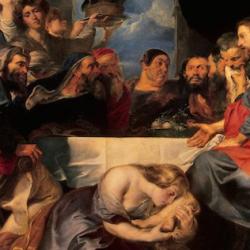Rebecca Denova(Things Accomplished Among Us) provides a good summary of the complex pattern of parallelism that structures Luke and Acts.
She points to the parallels between the gospel and the apostolic history: “The baptism of Jesus with water in Luke 3 is paralleled by the community’s baptism with the Spirit in Acts 2. Jesus’ message is rejected in Nazareth in Luke 4, and the community’s message is rejected in Jerusalem in Acts 3-5. Herod Antipas intends to kill Jesus in Luke 13, while Herod Agrippa attempts to kill Peter in Acts 12. Luke 14-18 contains the gospel to the outcasts, and Acts 13-20 contains a gospel that includes Gentiles. Chapters 9-19 of the Gospel contain Jesus’ journey to Jerusalem, and Acts 19-21 contains Paul’s journey to Jerusalem. Both Jesus and Paul suffer a passion and four trials (Luke 20-23 and Acts 21-26, respectively). The death of Jesus in Luke 23 is paralleled in Acts 27, with Paul’s ‘death’ at sea. In Luke 24, Jesus is resurrected, and Paul is ‘resurrected’ in Acts 28” (98-99).
Parallelisms structure Acts itself: “both Peter and Paul begin their missions with a sermon, summarizing the message (Acts 2.22-36; 13.16-41). They each have a harvest of souls to present at Pentecost (2.41-42; 20.16), and both of them confront magicians (8.18-24; 13.6-11). Peter and Paul each raise someone from the dead (9.36-42; 20.9-12), heal a lame person (3.1-10; 14.8-11), restrain Gentile worship of themselves (10.25-26; 14.13-15), are defended by Pharisees (5.34-39; 23.9), and both are selected for their job by the risen Lord (1.8; 23.11).” Both are “raised” like Jesus, though in different ways: Peter is raised from prison, Paul from the sea (99; land beast and sea beast?).
Paul’s journey parallel’s Jesus’ in many particulars: Both go to the city knowing they will suffer; Paul recounts his various trials to the elders at Miletus, as Jesus speaks of the disciples staying with him through trials (Luke 22.28); Jesus gives three prophecies of his passion, and Paul receives three prophecies about his future sufferings; both are charged with sedition, and both are judged innocent by the Roman authorities.
Overlaying these parallels are parallel chiasms. She cites Kenneth Bailey’s chiastic analysis of Luke’s journey narrative, which begins and ends in Jerusalem and centers on chapter 13. Parallel scenes are not strictly symmetrical. “What shall I do to be saved” appears in 10:25-41 and 18:18-30, but the latter gives a much longer answer. Luke 13:1-9 and 14:12-15:32 are about the kingdom, but the first is about a call to Israel and the second a call to the outcasts, the lost who respond to the call and leave the insiders outside (100).
On Acts, she refers to Donald Miesner’s chiastic analysis of Paul’s missionary journeys. Paul begins and ends his journeys in Jerusalem, and his time in Athens is at the midpoint. Again, the parallel sections are not strictly parallel: “Paul’s initial address in Antioch (13.14-52) is characterized negatively; the Jews reject him and his departure follows the shaking off of dust. But Paul’s farewell speech at Miletus (20.18-38) is characterized positively; the elders receive him and his departure amid weeping, kissing, and embracing” (101).















